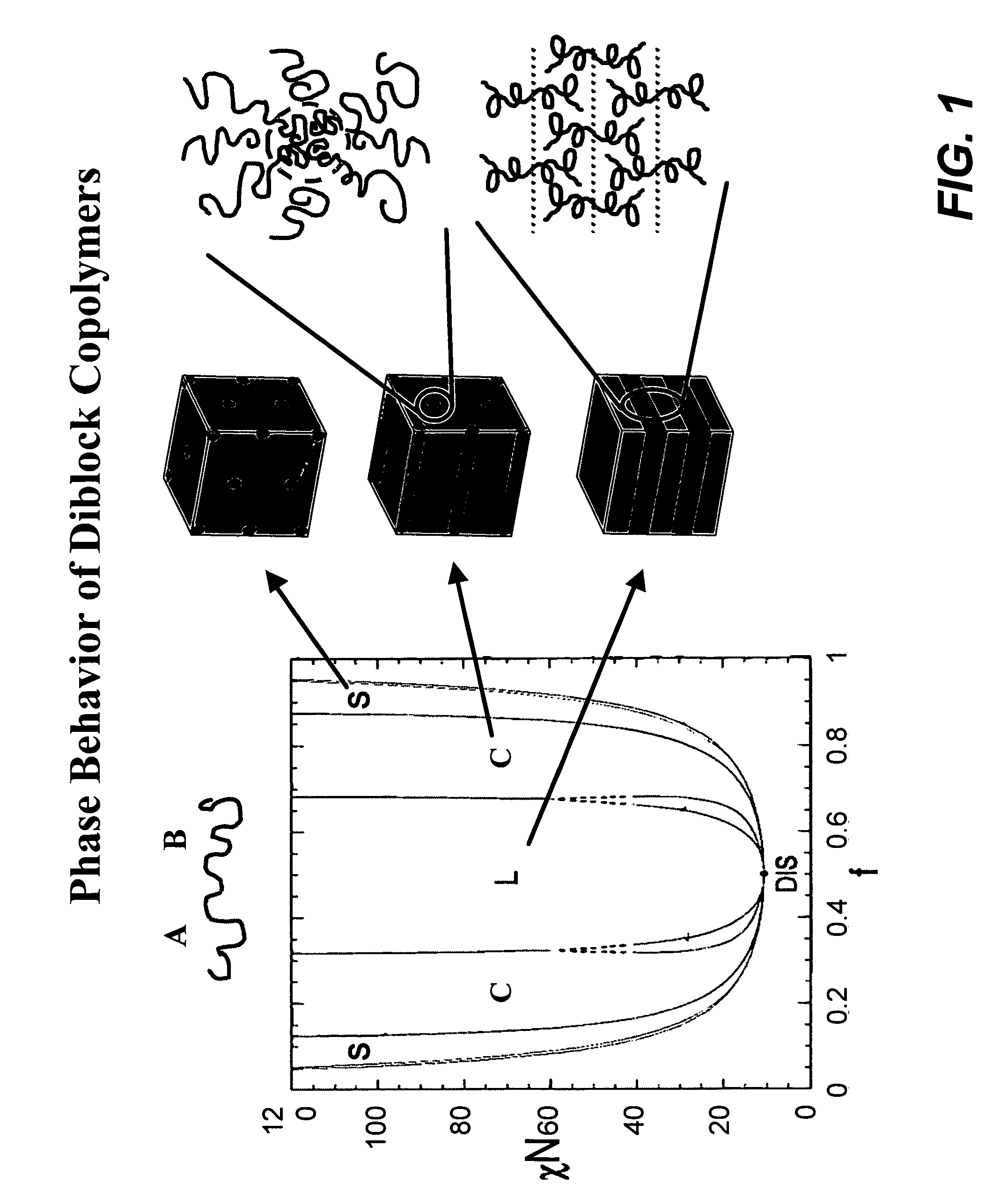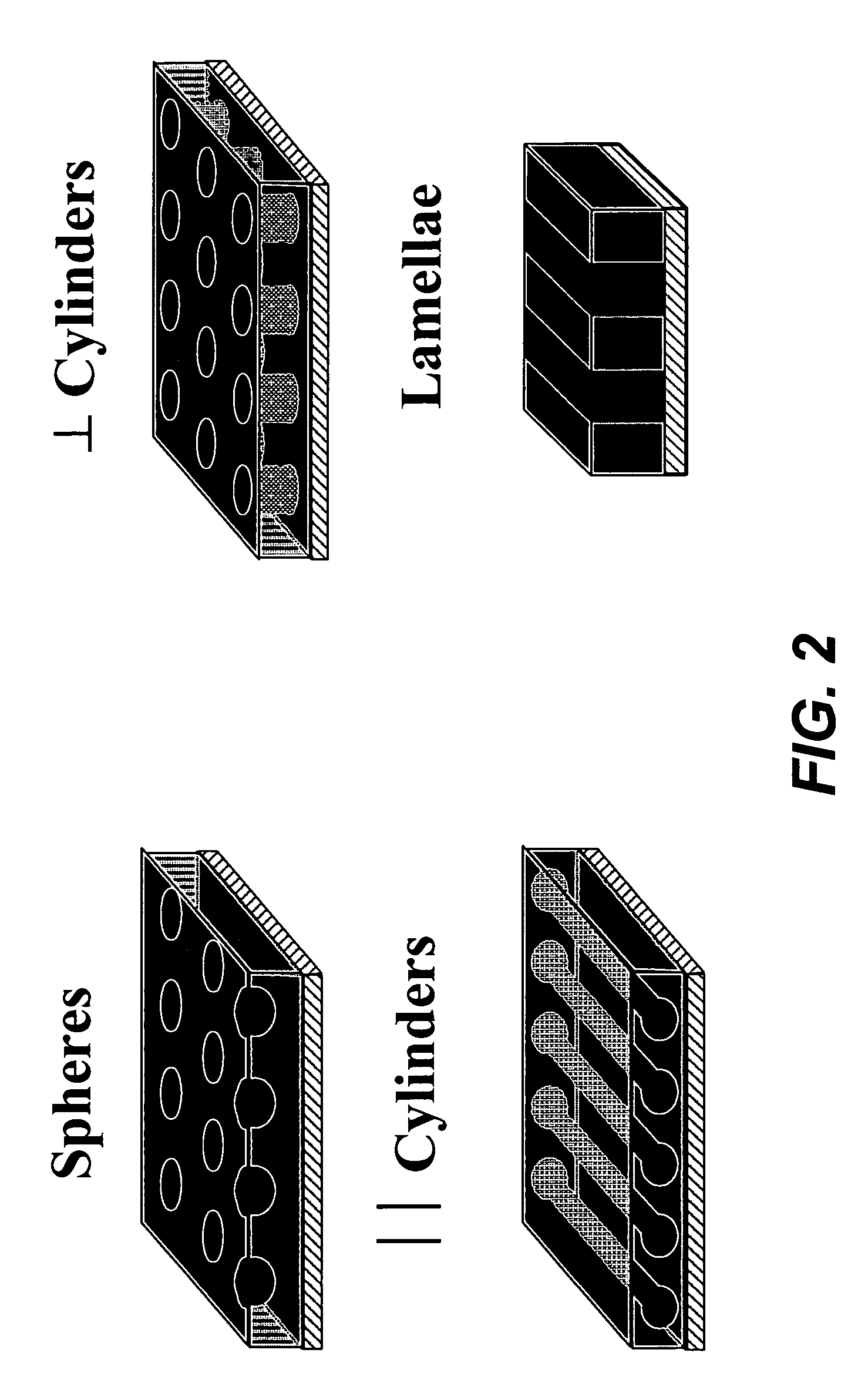Directed assembly of triblock copolymers
a triblock and self-assembling technology, applied in the field of nanofabrication techniques, can solve the problems of limited use of directed self-assembly, defects in patterns of approaches relying solely on copolymer self-assembly, and limitations of existing methods of using block copolymer materials
- Summary
- Abstract
- Description
- Claims
- Application Information
AI Technical Summary
Benefits of technology
Problems solved by technology
Method used
Image
Examples
example 1
[0087]A representative example polymerization of poly(isoprene-b-styrene-b-ethylene oxide) (PI—PS—PEO) or PISO for shorthand, is conducted with the following steps. All monomers are purified by destructive distillation while the polymerization solvents are passed over activated silica columns and all reagents are isolated from air and other contaminants. A specified amount of sec-butyllithium is added to cyclohexane followed by isoprene with subsequent polymerization for roughly four hours at 40° C. Addition of styrene along with a small amount of tetrahydrofuran (THF) leads to the rapid crossover from isoprenyllithium to styryllithium and chain growth, again at 40° C. After approximately four hours the reaction is terminated with a ten-fold excess of ethylene oxide followed by addition of HCl in methanol, which terminates each chain with an alcohol group. The PI—PS—OH product is recovered by extraction, precipitation, and washing, then redissolved in THF and reinitiated with potass...
example 2
[0088]A triblock copolymer (PEO—PI—PS) that forms three-phase lamellar structures (see structure a in FIG. 3A) was directed to assemble on chemically nanopatterned surfaces having alternating stripes of polar and non-polar functionality. The PEO preferentially wets the polar stripes on the surface, and the PI and PS preferentially wet the non-polar stripes of the surface.
[0089]FIG. 8A shows a schematic representation of the procedure used to create the nanopatterned substrates and FIGS. 8B and 8C show results. First, in FIG. 8A, a representation of the PEO—PI—PS block copolymer is shown, with the PI represented by a dotted pattern, PS a lighter grey solid and PEO a darker grey solid. The binary patterned imaging layer is shown, with the differently striped areas illustrating the patterning. The PEO—PI—PS block copolymer material is then deposited on the binary pattern and direct to self-assemble on the pattern. The result is three-phase lamellar morphology formed by the triblock cop...
example 2a
[0091]A binary striped binary pattern was created on a substrate by depositing a PS brush on the substrate and a photoresist layer on the brush. The photoresist was patterned by EUV interference lithography to create lines 25 nm apart. The photoresist pattern was replicated to the PS brush by exposure to an oxygen plasma. Excess photoresist was then removed using solvent rinses to result in a layer patterned with alternating stripes of a PS brush and an oxygenated PS brush. The pattern period (width of two adjacent stripes) was 50 nm.
[0092]A triblock PISO copolymer (I=33.4%; S=34.2%; 0=32.4% by volume; Phase: Lam3; L0=50.9 nm) was deposited on the binary patterned substrate. The PS brush was wet by PS and PI and the oxygenated PS brush by PEO.
[0093]FIG. 8D shows an image of the assembled PISO. FIG. 8D also shows a schematic of the assembled PISO and its dimensions that is consistent with image and believed to be the resulting structure. As can been seen from the schematic, the PEO a...
PUM
| Property | Measurement | Unit |
|---|---|---|
| Dimension | aaaaa | aaaaa |
| Distance | aaaaa | aaaaa |
| Wetting tension | aaaaa | aaaaa |
Abstract
Description
Claims
Application Information
 Login to View More
Login to View More - R&D
- Intellectual Property
- Life Sciences
- Materials
- Tech Scout
- Unparalleled Data Quality
- Higher Quality Content
- 60% Fewer Hallucinations
Browse by: Latest US Patents, China's latest patents, Technical Efficacy Thesaurus, Application Domain, Technology Topic, Popular Technical Reports.
© 2025 PatSnap. All rights reserved.Legal|Privacy policy|Modern Slavery Act Transparency Statement|Sitemap|About US| Contact US: help@patsnap.com



